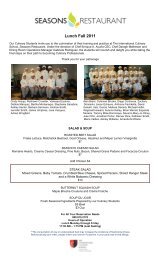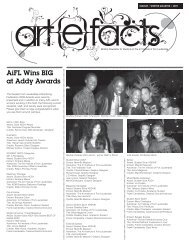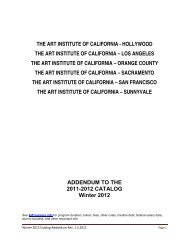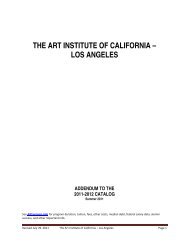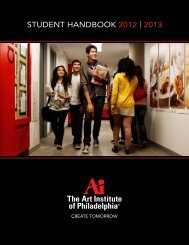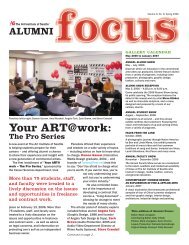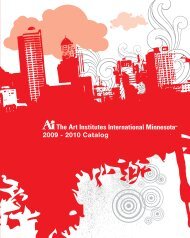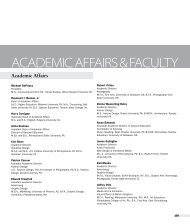2011-2013 CATALOG - The Art Institutes
2011-2013 CATALOG - The Art Institutes
2011-2013 CATALOG - The Art Institutes
You also want an ePaper? Increase the reach of your titles
YUMPU automatically turns print PDFs into web optimized ePapers that Google loves.
Deans of Academic Affairs are responsible for<br />
determining the appropriateness of the<br />
mitigating circumstance in regards to severity,<br />
timeliness, and the student’s ability to avoid<br />
the circumstance. Any consideration of<br />
conditions outside of the list provided should<br />
be discussed with the EDMC VPAA. Student<br />
life issues and making the transition to college<br />
are not considered mitigating circumstances<br />
under this policy since students have at least<br />
two quarters in a diploma and three quarters in<br />
a degree program to adjust to college life.<br />
Documentation from a school or professional<br />
counselor should not breach the student/<br />
counselor relationship. A memorandum or letter<br />
on school or organizational letterhead indicating<br />
a counselor’s opinion that student issues are<br />
contrary to satisfactory academic progress will<br />
suffice as proof of mitigating circumstances.<br />
20. Grades achieved in repeated classes will replace<br />
grades of ‘F’, ‘W’, or ‘WF’. Grades of ‘F’,’W’, or<br />
‘WF’ are included in the maximum allowable<br />
time frame and incremental completion rate<br />
requirements. <strong>The</strong> grade ‘I’ indicates Incomplete<br />
and is calculated as if it is an ‘F’ until it is changed<br />
to another grade. Students may also retake<br />
classes in which they received a passing grade in<br />
order to improve their CGPA. However, a student<br />
cannot receive financial aid for repeating courses<br />
in which a passing grade has already been earned.<br />
21. Transfer credits from other post-secondary<br />
institutions are not calculated in the maximum<br />
allowable credits or incremental completion rate<br />
requirements; however, transfer credits do reduce<br />
the total number of credits that must be attempted<br />
within the program. <strong>The</strong>refore, the maximum<br />
number of attempted credits for a student with<br />
transfer credit is one and one-half times the number<br />
of credits required to complete for graduation.<br />
Example: if a student transfers 36 credits to a<br />
program consisting of 180 credits, the calculation<br />
would be 180 – 36 = 144 X 1.5 = 216 credits.<br />
Grades for credits transferred from any<br />
post-secondary institution (including an <strong>Art</strong><br />
Institute) will be recorded as “TR” in the Student<br />
Information System and will not affect the<br />
student’s CGPA.<br />
Students wishing to transfer from one <strong>Art</strong><br />
<strong>Institutes</strong> school to another may do so only if<br />
they are in good standing at the sending school.<br />
Any student dismissed for academic progress<br />
cannot transfer to another <strong>Art</strong> <strong>Institutes</strong> school<br />
until he or she has been reinstated at the sending<br />
school and is deemed to be making satisfactory<br />
academic progress.<br />
22. Students will be allowed only one change of<br />
program. On rare occasions and with good reason,<br />
the Dean of Academic Affairs may allow a student<br />
an additional change of program. Changing<br />
from day to evening in the same program is not<br />
considered a change of program. Changing from<br />
a diploma level to a degree level or an associate’s<br />
level to a bachelor’s level in the same program is<br />
not considered changes of program.<br />
Courses taken in one program applicable to the<br />
second program shall be transferred with the<br />
grade. If students have taken a course more than<br />
once, all grades pertinent to that course shall<br />
apply to the second program. Grades earned<br />
in the original program shall count towards the<br />
cumulative grade point average.<br />
However, in cases in which a student has graduated<br />
from the Institute in one program then<br />
subsequently begins work in a different program,<br />
grades used in the CGPA of the previous program<br />
will not be applied to the student’s new program<br />
CGPA calculation. <strong>The</strong> grades will be recorded<br />
as TR.<br />
For ICR purposes only, those courses transferred<br />
will apply to the new program. <strong>The</strong> maximum<br />
allowable timeframe shall be calculated as the<br />
total number of credits in the program minus the<br />
number of credits applied to the new program<br />
X 1.5. Example: if a student transfers 36 credits<br />
to a program consisting of 180 credits, the<br />
calculation would be 180 – 36 = 144 X 1.5 = 216<br />
credits. Second example, if a student earned 36<br />
credits in the original program that are applicable<br />
to the new program, but transfers 48 credits due<br />
to repeating failed classes then the maximum<br />
allowable timeframe is reduced to 198 credits.<br />
23. In order for students to graduate, the minimum<br />
requirements are a CGPA of 2.0, and completion<br />
of the program in no more than 150% of total<br />
program credits.<br />
Milestones and Evaluation Points<br />
Degree<br />
Evaluation<br />
Point<br />
End of Second<br />
Quarter<br />
End of Third<br />
Quarter<br />
End of Third<br />
Quarter<br />
End of Sixth<br />
Quarter and<br />
every quarter<br />
thereafter<br />
Milestones<br />
(CGPA and ICR)<br />
< 1.0 and/or<br />
33.33%<br />
< 1.0 and/or<br />
33.33%<br />
< 1.5 and/or 50%<br />
>1.0 and 33.33%<br />
Required<br />
Action<br />
Probation<br />
Dismissal<br />
Probation<br />
< 2.0 and 66.67% Dismissal<br />
If a student’s CGPA falls below 2.0, but is at least 1.8<br />
and/or the ICR is below 66.67% but at least 60%, the<br />
student may be placed on probation one time after<br />
he or she has moved beyond his or her sixth quarter.<br />
<strong>The</strong> student would then need to achieve the 2.0 and<br />
66.67% milestones at the next evaluation point<br />
or be dismissed.<br />
ACADEMIC<br />
HONESTY POLICY<br />
<strong>The</strong> Academic Affairs Team of <strong>The</strong> <strong>Art</strong> Institute of<br />
Phoenix fosters a teaching/learning environment<br />
where academic honesty must be maintained.<br />
Students are ultimately responsible for following this<br />
policy by presenting their own work and properly<br />
crediting other contributors or sources. Sometimes,<br />
students are uncertain about what constitutes<br />
appropriate citation of work by others. If you are<br />
unsure how to document work written or presented<br />
by others, it is your responsibility to ask for help.<br />
Resources are available in the Library or ask<br />
your instructor.<br />
All work is expected to be your own, and all referred<br />
sources included in the work must be appropriately<br />
cited. Plagiarism is the act of taking credit for any<br />
work, or portion of work, without proper reference<br />
and permission. Plagiarism, as well as other forms of<br />
academic dishonesty, is a serious offense and may<br />
result in the assignment of a failing grade or expulsion<br />
from <strong>The</strong> <strong>Art</strong> Institute of Phoenix.<br />
Academic Dishonesty<br />
<strong>The</strong> maintenance of academic integrity and quality<br />
education is the responsibility of each student within<br />
this school. Cheating or plagiarism in connection with<br />
an academic program is an offense for which a student<br />
may be expelled, suspended, or given a less severe<br />
disciplinary sanction. Academic dishonesty is an<br />
especially serious offense, diminishing the quality of<br />
scholarship and defrauding those who depend upon<br />
the integrity of the school programs.<br />
Such dishonesty includes:<br />
A. Cheating<br />
Intentionally using or attempting to use unauthorized<br />
materials, information, or study aids in any academic<br />
exercise. Comments:<br />
1. Faculty members will state in advance their<br />
policies and procedures concerning examinations<br />
and other academic exercises, as well as the<br />
use before examinations of shared study aids,<br />
examination files, and other related materials and<br />
forms of assistance.<br />
2. <strong>The</strong> utilization of any external assistance<br />
(e.g., books, notes, calculators, conversation<br />
with others) when taking an examination or<br />
competing is prohibited unless specifically<br />
authorized by the instructor.<br />
3. Students must conduct their own research or<br />
prepare their own work. Services of commercial<br />
term paper companies are not permitted.<br />
4. Substantial portions of the same academic work<br />
may not be submitted for credit in more than one<br />
course without authorization.<br />
B. Fabrication<br />
Intentional falsification or re-invention of any<br />
information or reference source or citation in an<br />
academic exercise. Comments:<br />
1. Re-invented: <strong>The</strong> use of previously created<br />
information or design may not be used in any<br />
“lab” or academic exercise without notice to and<br />
authorization from the instructor and original<br />
creator. It would be improper, for example, to<br />
covertly “design” a project that had previously<br />
been designed by another party without proper<br />
acknowledgement of who/whom is the original<br />
source of the design.<br />
2. Students who attempt to alter and resubmit<br />
returned academic work with intent to defraud the<br />
faculty member will be in violation of this section.<br />
For example, a student may not change an answer<br />
on a returned exam and then claim that he/she<br />
deserves additional credit.<br />
C. Facilitating Academic Dishonesty<br />
Intentionally or knowingly helping or attempting<br />
to help another to commit an act of academic<br />
dishonesty. Comments:<br />
1. For example, one who knowingly allowed another<br />
to copy from his or her paper during an examination<br />
D. Plagiarism<br />
Intentionally or knowingly representing the words,<br />
ideas, or work of another as one’s own in any<br />
academic exercise. Comments:<br />
1. Direct Quotations: Every direct quotation must be<br />
identified by quotation marks, or by appropriate<br />
indention or by other means of identification,<br />
and must be properly cited in a footnote. Proper<br />
footnote style for any academic department is<br />
outlined by the MLA or APA Style Sheet.<br />
THE ART INSTITUTE OF PHOENIX <strong>2011</strong>-<strong>2013</strong> COURSE <strong>CATALOG</strong> 69



